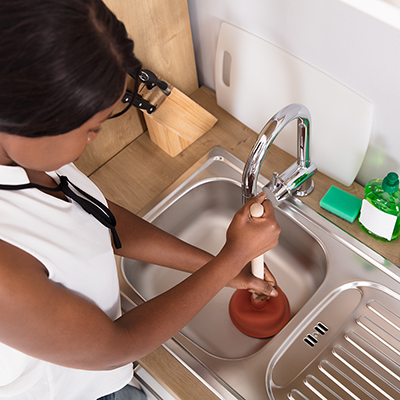Septic System Maintenance and Care Guide

Last updated April 4, 2025
Many homes aren’t connected to a municipal sewer system. These homes use septic systems to treat the sewage and wastewater produced by the household. Septic systems are buried in the ground and are made up of a large tank, a distribution box, and a drain field, also called a leech field.
There is a long list of things that should never go into a septic system, either by being washed down a drain or flushed down a toilet. The list includes harsh chemicals, baby wipes, hygienic wipes, feminine hygiene products, anything plastic, hair and more.
Items, like wipes, that are marked as flushable should never be flushed into a septic system. They will not break down and will clog the system. Usually, flushing something bad doesn't cause an immediate problem. It starts or contributes to a problem that grows, undetected, over time. It will add up and require emergency professional services. A severe clog can cause water and sewage to back up into the home, creating a messy, unsanitary problem.
Difficulty:
Beginner
Duration:
Under 2 hours
Table of Contents
How Does a Septic System Work
Importance of Maintenance
How Do You Know if the Tank Is Full or Having Other Problems
Everyday Actions for a Better Septic System
Keep the Bacteria Alive
More Steps for a Better Septic System
How Does a Septic System Work

All drain pipes in the house, like those from sinks, tubs and toilets, lead to one large drain pipe. This large pipe is connected to the inlet side of the septic tank. A baffle separates the inlet side from the outlet side. On the inlet side, the waste separates into three main parts: solids are at the bottom, liquids are in the middle, and a scum layer floats on top.
In a properly functioning system, water flows over the baffle to the outlet side of the tank. Bacteria and enzymes break down the solids and they become part of the liquids over time.
Liquids flow from the outlet end of the tank into the distribution box. From here, it continues to flow into one of the perforated drain field pipes. As it flows down the drain field pipe, the liquid seeps into the ground through the perforations and is filtered by rock and soil before it goes back into the ground water.
Importance of Maintenance

The scum layer is made up of the things that float on top and will not break down. If the system is maintained properly and cleaned regularly, this scum layer will be removed when the tank is professionally cleaned. If the system isn’t maintained, this scum layer will begin to wash into the drain field and start clogging the perforations in the pipes. The eventual end is a completely clogged system that must be dug up and replaced at a cost running into the tens of thousands of dollars.
Newer systems will have an effluent filter at the outlet. This filter is in place to keep the drain field from becoming clogged. The filter itself can become clogged and cause the tank to overflow. It can be clogged over time by grease and solids. It can also clog quickly with items like baby wipes. This will require opening the tank to remove and clean the filter.
The scum layer can only be removed by having the tank pumped by a professional septic tank service. It’s made primarily of oil and grease but can also include flushed items like hygiene products. Anything that gets washed down the drain or flushed down the toilet that can’t be broken down by the enzymes and bacteria floats on the surface until it is removed by pumping.
How Do You Know if the Tank Is Full or Having Other Problems

- A full septic tank will often seem like a clogged drain line. Pipes will gurgle and water will back up in the lowest drain first, usually a first-floor shower or bathtub.
- You may find wet patches in the yard, around the tank or in the drain field.
- There may be spots in the yard where the grass grows exceptionally well compared to the rest of the yard.
- A sewage smell may be present in the drains or in the yard.
Everyday Actions for a Better Septic System

Here are some simple daily steps to help ensure a healthy septic system.
- In the kitchen, don’t put fat, oil, grease or uneaten food down the drain. The drain for the dishwasher goes into the septic as well, so scrape the dishes before they go into the dishwasher. Pour excess frying oil from the pan into a container for reuse or disposal.
- In the bathroom, only flush organic waste (you know what that is) and toilet paper down the toilet. Anything else will eventually cause septic system problems. Don’t wash hair down the sink or shower drain; pick it up and put it in the trash. Install low water usage shower heads and toilets. An old toilet might use several gallons to flush while a dual-flush toilet can use as little as 1.1 gallons per flush.
- In the laundry room, wash clothes throughout the week rather than running the washer all day once a week. There's no set number of loads that can be run in a day, but keep in mind that a clothes washer uses a great deal of water. Running many loads one after the other can fill the tank faster than it can empty. When washing, select the proper water fill level for the amount of clothing. Measure detergent so that the minimum amount is being used. A high efficiency washer will use less water and detergent per wash.
- In the utility room, never pour any chemical, solvent or paint down the drain. Don’t wash paint brushes in the sink. These items can kill the helpful bacteria that makes the system work or clog the filter and drain field.
- Some of these steps are inconvenient but none match the inconvenience of paying a large sum of money to have your yard dug up with a backhoe.
Keep the Bacteria Alive

How do I keep my septic system healthy? Be sparing with bleach, antibacterial soaps and harsh cleaning supplies. We all like cleaning products that kill bacteria, but they also kill the bacteria that makes a septic tank work. Where appropriate, consider cleaning products that don’t kill bacteria.
Even if care is taken, a septic tank treatment is needed to keep the bacteria and enzymes in good shape. Follow the manufacturer’s directions for application.
More Steps for a Better Septic System

Part of keeping a septic system in good working order is what goes into it. The other part is what happens in the area above and around it.
- The tank and drain field need some protection. As they are essentially hollow, they can’t support extreme weight like a car or truck. Driving over them may cause damage underground. There have been cases of septic tanks breaking and collapsing under the weight of a vehicle.
- Concrete, hardscapes or buildings are heavy and make the ground less permeable. The tank and drain field area should be avoided when building these things. Also, be mindful of how placement of these things will impact a service truck’s access to the system.
- Know where your tank and drain field are when digging holes. Utility location services are unlikely to know where these items are.
- Reducing water usage in general is a good idea.
- Route stormwater runoff from the ground and the roof gutters away from the drain field. If the ground is saturated with water from above it can’t effectively deal with the water going through the system.
- If water from the landscape flows into or through the drain field, it would be helpful to route that water away from it. French drains or landscape contouring may be needed.
Professional Maintenance

Maintaining a septic system is a “pay me now or pay me later” situation. If the system doesn’t seem to be causing any problems, it may seem cheaper to skip regular professional maintenance. However, skipping regular service calls will eventually create a problem that requires an expensive repair.
- Neglected maintenance will often result in a septic tank with capacity that is reduced by layers of hard solid deposits that take a great deal of time and effort to remove. A tank cleaning company will charge more if the job takes more time and effort.
- Depending on the system and number of people in the household, figure on having a preventative maintenance service call every 3 to 5 years. If buying a home with a septic system, consider having a septic professional inspect the system before closing.
- Many people ask “Can I clean a septic tank myself?” Unfortunately, this is a job that requires expensive, professional equipment and knowledge of how systems work. The contents that are pumped out must be disposed of at a wastewater facility. Cleaning a septic tank is one of those jobs that isn’t DIY. Using a small pump to remove excess water will only make problems worse and there is no sanitary way to dispose of many gallons of sewage water.
Add a Septic Tank Riser

A septic tank is buried in the ground. Depths vary but it could be up to several feet deep. A riser bridges the gap between the top of the tank and the surface of the ground.
Locating and digging for the septic tank can be a large portion of the cost of a septic tank service. Consider adding a septic tank riser. While not inexpensive, it could pay for itself in several cleanings, and will prevent having a large hole dug in your lawn every time the tank is serviced.
Complicated Septic Systems

Most septic systems are simple and use nothing more than gravity to move sewage through the process. Some systems require the use of pumps and multiple tanks or cesspools. In these cases, refer to the manufacturer’s guidance when selecting and maintaining the pumps and related plumbing.
Maintaining a septic system is easy. Using additive treatments and being careful about what goes down the drain are simple steps.
Use our Pro Referral Service to find a local professional to schedule a cleaning.



























